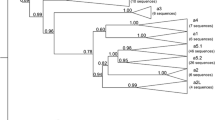Abstract
The immune capacity of young and adult axolotls (Ambystoma mexicanum) was evaluated by examining the combinatorial and junctional diversity of the VH chain. A large number of VDJ rearrangements isolated from 2.5-, 3.5-, 10-, and 24-month-old animals were sequenced. Six JH segments were identified with the canonical structure of all known vertebrate JHs, including the conserved Trp103-Gly104-X-Gly106 motif. Four core DH-like sequences were used by most (80%) of the VDJ junctions. These G-rich sequences had structures reminiscent of the TCRB DB sequences, and were equally used in their three reading frames. About 25% of the Igh, VDJ junctions from 3.5-month-old axolotls were out of frame, but most rearrangements were in frame at 10 and 24 months, suggesting that there is active selection of the productively rearranged Igh chains in the developing animals. There was no significant difference between the size of CDR3 in young (3.5 months) and subadult (10 months) axolotls (mean: 8.5 amino acids). However, the CDR3 loop was 1 amino acid longer in 2-year-old adult animals (mean: 9.5 residues). Several pairs of identical VDJ/CDR3 sequences were shared between 3.5-month-old individually analyzed axolotls, or between groups of axolotl of different ages. These identical rearrangements might be provided by the selection of some B-cell clones important for species survival, although the probability that different 3.5-month-old axolotl larvae would produce identical junctions seems very low, considering their limited number of B cells (less than 105). The high frequency of tyrosine residues and the paucity of charged residues in the axolotl CDR3 loops may explain the polyreactivity of natural antibodies, and also clarify why it is so difficult to raise specific antibodies against soluble antigens.
Similar content being viewed by others
Author information
Authors and Affiliations
Additional information
Received: 11 March 1997 / Revised: 1 May 1997
Rights and permissions
About this article
Cite this article
Golub, R., Fellah, J. & Charlemagne, J. Structure and diversity of the heavy chain VDJ junctions in the developing Mexican axolotl. Immunogenetics 46, 402–409 (1997). https://doi.org/10.1007/s002510050294
Issue Date:
DOI: https://doi.org/10.1007/s002510050294




